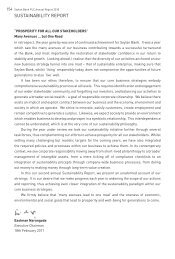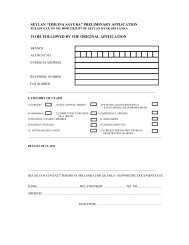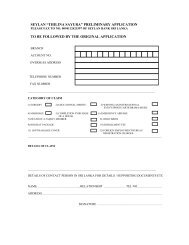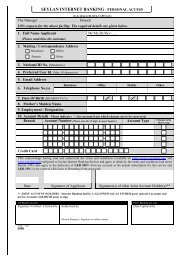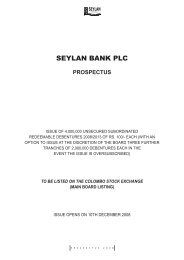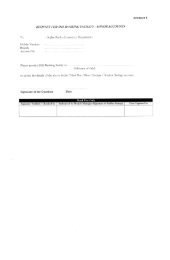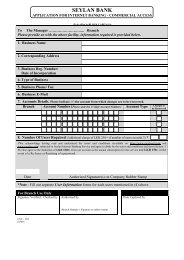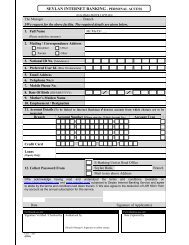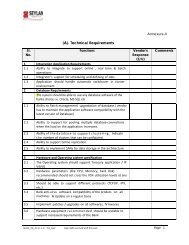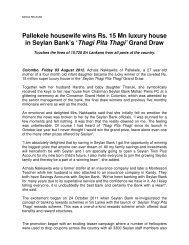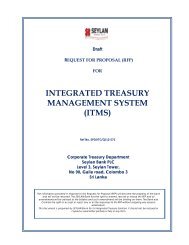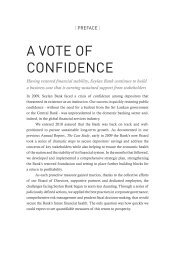Notes to the Consolidated Financial Statements - Seylan Bank
Notes to the Consolidated Financial Statements - Seylan Bank
Notes to the Consolidated Financial Statements - Seylan Bank
You also want an ePaper? Increase the reach of your titles
YUMPU automatically turns print PDFs into web optimized ePapers that Google loves.
290 North Bound > <strong>Seylan</strong> <strong>Bank</strong> Annual Report 2011<br />
<strong>Notes</strong> <strong>to</strong> <strong>the</strong> <strong>Consolidated</strong> <strong>Financial</strong> <strong>Statements</strong><br />
In implementation of new products that invariably rely on technology as well as human involvement,<br />
a risk review is an essential aspect that needs both <strong>the</strong> marketing objectives as well as <strong>the</strong> Risk Management<br />
requirements. The <strong>Bank</strong> strives <strong>to</strong> subject such new product introductions <strong>to</strong> adequate review.<br />
The <strong>Bank</strong> also maintains its policies with regard <strong>to</strong> access control and data protection and necessary<br />
safeguards are constantly introduced and upgraded <strong>to</strong> ensure <strong>the</strong> integrity of <strong>the</strong> information and <strong>the</strong> data<br />
bases. Preventive measures such as firewalls and virus guards among o<strong>the</strong>r steps are put in place.<br />
(g) Capital Management<br />
Capital Adequacy is a measure of a commercial bank’s ability <strong>to</strong> withstand <strong>the</strong> associated risks of its business.<br />
Regula<strong>to</strong>rs find it necessary that every bank holds adequate capital <strong>to</strong> absorb unexpected losses as a going<br />
concern, while <strong>the</strong>y price <strong>the</strong>ir products and services <strong>to</strong> take care of expected risks. Capital Adequacy Ratio<br />
(CAR) was measured on <strong>the</strong> basis of credit and market risk under <strong>the</strong> Basel I accord and under Basel II, it<br />
takes in<strong>to</strong> account <strong>the</strong> credit, market and operations risks. Keeping with <strong>the</strong> international standards of Basel<br />
Committee on <strong>Bank</strong>ing Regulations and Supervisory Practices, Sri Lanka has been following Basel II CAR<br />
calculation from January 2008 after conducting parallel calculations in 2007.<br />
(g i) Available Capital<br />
Basel I and Basel II accords recognise three capital elements, namely, Tier I, Tier II and Tier III capital.<br />
Tier I capital includes paid up ordinary share capital, paid up non-cumulative, non-redeemable preference<br />
shares, share premium, statu<strong>to</strong>ry reserve fund, published retained earnings, general and o<strong>the</strong>r reserves,<br />
less goodwill.<br />
Tier II capital includes 50% of asset revaluation reserves (created by revaluation carried out in every<br />
seven years) general provision for advances, hybrid debt/equity instruments and approved subordinated<br />
term debts. Tier II capital cannot exceed Tier I capital and subordinated debt cannot exceed 50% of <strong>the</strong><br />
Tier I capital.<br />
Tier III capital will consist only of short-term debt instrument and will be used for calculation of market risk<br />
only. Tier III is subject <strong>to</strong> a maximum of 250% of Tier I capital after meeting <strong>the</strong> credit and operational risk.<br />
Equity investments in unconsolidated banking and financial subsidiaries and investments in capital of<br />
o<strong>the</strong>r banks/financial associates are deducted from capital in arriving at <strong>the</strong> capital base. The <strong>Bank</strong> is<br />
required <strong>to</strong> maintain a minimum <strong>to</strong>tal risk-weighted capital ratio of 10% in respect of Domestic <strong>Bank</strong>ing<br />
Unit (DBU) and Foreign Currency <strong>Bank</strong>ing Unit (FCBU) operations.<br />
<strong>Bank</strong><br />
Group<br />
Capital Adequacy Details - 31st December 2011 2010 2011 2010<br />
Rs. Mn. Rs. Mn. Rs. Mn. Rs. Mn.<br />
Total Tier I Capital 16,625 11,554 17,365 11,936<br />
Total Tier I & II Capital 17,232 13,180 18,011 13,601<br />
Total Risk-Weighted Assets 110,814 109,192 112,628 111,133<br />
Off-Balance Sheet Exposure 5,914 4,934 5,914 5,001<br />
Capital Adequacy Ratios<br />
Tier I 15.00% 10.58% 15.42% 10.74%<br />
Tier I & II 15.55% 12.07% 15.99% 12.24%



